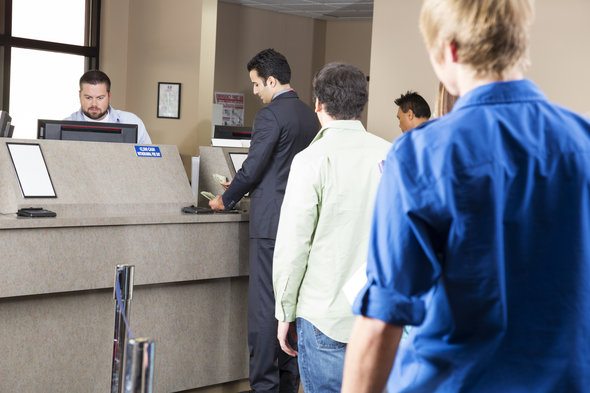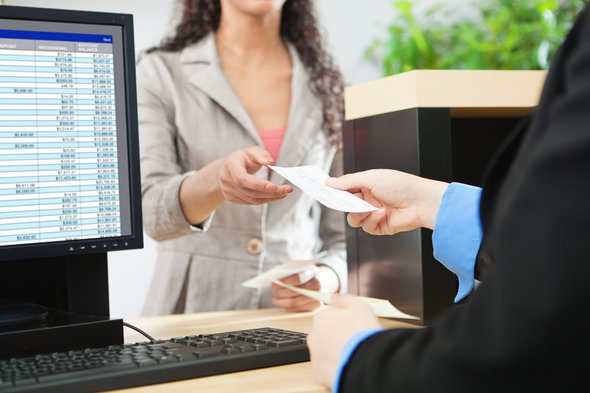A cashier’s check is often necessary for big purchases, like a down payment on a home. A cashier’s check is drawn from a bank’s account and is therefore as highly regarded as cash. You cannot bring a regular personal check to a home closing because the seller will be handing over the deed to the house, leaving no time for the check to clear. That is why a cashier’s check is often required for large or official purchases.
Do you have questions about how managing your bank account can affect your larger financial plan? Speak with a financial advisor today.
What Is a Cashier’s Check?
Cashier’s checks, also known as teller’s checks, are checks that draw on your bank’s own funds to make payment. Once a bank creates a cashier’s check, your bank guarantees to pay the amount printed on the check. A legitimate cashier’s check will not bounce.
To get a cashier’s check, you need to bring cash to the bank. If you already have an account there, the bank can instead withdraw the funds directly from your account, moving it to its own. The money will then be available when the payee cashes the check.
A cashier’s check is different from a personal check because the money is drawn from the bank’s account. With a personal check, the money is drawn from your own account, which may or may not have enough money to cover the check. Also, it is difficult to cancel a cashier’s check once it is complete. With a personal check, you just rip it up or call the bank to stop payment.
When to Use a Cashier’s Check
People often use cashier’s checks for large purchases where it is not practical or feasible to bring cash. Buying real estate is a good example because you would not hand over such large amounts of money without receiving the deed right away, and the seller wouldn’t hand over the deed without a guaranteed form of payment. Since a financial institution’s account backs a cashier’s check, a cashier’s check is one of the most secure forms of payment.
Cashier’s checks are also useful in time-sensitive transactions. The funds are usually available immediately—and in most cases, the next day. If you are looking to make a big purchase, a cashier’s check may be the quickest and safest way to go.
Here are some other purposes for a cashier’s check:
- A down payment on a home
- Closing costs when buying real estate
- Land purchase
- Car purchase, made with cash or for a down payment
- Boat purchase with cash
- Business investment
- Large tax debt
- Big college tuition payment
- Wedding costs
In many of these situations, a cashier’s check may be the safest payment option, but that does not mean that you have to use one. There are alternatives that you can explore to see if there are better options for your situation.
Where Can I Get a Cashier’s Check?

You can purchase a check from a bank teller or through your bank’s online system if your bank offers that service. You will need to provide identification and other relevant information, such as the amount of the check, the correct spelling of the payee’s name and any memo notes. This info is printed on the check – nothing can be handwritten or crossed out.
If you have an account with the institution, the amount you request comes out of your personal account and goes to the bank’s own account. If you do not have an account with the bank, you may be able to pay with cash. Once the teller prints and signs the check, it is ready for use.
Keep in mind that some banks sell cashier’s checks only to their customers. If you do not have a bank account, you should call before going to any bank to make sure they will issue you a cashier’s check anyway.
The process of getting a cashier’s check at a credit union is similar. One difference, though, is that you can usually get a cashier’s check from almost any credit union, regardless of whether you are a member.
The last option is to order a cashier’s check online. This varies from place to place, but most banks will only offer this option to their customers.
When you request a cashier’s check online, the bank will send a physical check to your mailing address. That makes it your responsibility to get it to the recipient. This saves you a trip to the bank, but it will still take longer since you have to rely on the mail.
Risks of Using Cashier’s Checks
Cashier’s checks offer a safe method of payment. Security features printed onto the check prevent any possible forgery, but counterfeiting scams do still occur.Many times, the victim receives a cashier’s check in the mail from an unknown person, who then asks the victim to send some of the money back.
A fraudulent cashier’s check will likely clear immediately when first deposited. This is because the bank has guaranteed that the funds will be available. When the bank discovers that the check is a forgery (often a few weeks after the deposit) they take the money back. Unfortunately, the recipient is out of pocket for any money that has been spent.
Because of this, you should take extra precautions with a cashier’s check that a stranger sends to you as a gift, reward or unexpected refund. Show it to a teller to certify that the check is legitimate. If you are really concerned, wait several weeks to make sure the check has cleared before you spend any of the funds.
How Much Does a Cashier’s Check Cost?
There aren’t a ton of situations in life where you need a cashier’s check. However, when you do, they typically do not come free. While cashier’s check fee rates usually are not more than a few dollars, they are not given to you like a typical checkbook.
At many of America’s largest banks, fees top out at around $10 – $15.
- Wells Fargo: $10, plus $8 delivery fee if mailed
- Citi: $10
- Bank of America: $15
- Santander Bank: $10
- U.S. Bank: $10
- Capital One: $10, plus $20 delivery fee if mailed
- PNC Bank: $10
- Ally Bank: $0
Some online banks will offer something similar to a cashier’s check for free called an official bank check. You should check directly with your bank to see what the cost might be.
Alternatives to a Cashier’s Check

There are a few options for those who do not want to pay the fee for a cashier’s check. However, keep in mind that some of these alternatives may have a separate fee. Check directly with your bank before moving forward.Personal Check
A personal check is one way to handle large purchases. Funds are taken directly from your account. However, if there are not enough funds available and a check bounces, the recipient will not receive the funds. That is why a cashier’s check is often preferred for large purchases.
Peer-to-Peer Payment Apps
Mobile banking apps like Venmo, Zelle and PayPal have increased in popularity for their overwhelming convenience. You can link these apps directly to your bank account so you can make payments of all sizes. Once you authorize the payment, the funds are typically deducted from your account immediately, lowering the chances of your payment being rejected.
Bank Draft
You can always set up a bank draft. It is similar to a check but it is backed by your bank, guaranteeing that the funds are available for the transfer. The funds are taken from your account and held with the bank until the recipient cashes the draft.
Money Order
Perhaps the most viable alternative to a cashier’s check is a money order. This is another form of guaranteed payment that is usually more readily available since you can purchase them from banks, post offices and some retail stores. You can buy a money order with cash or a debit card.
Just note that money orders tend to have a cap amount of $1,000. Cashier’s checks do not have these limits, making them more useful for larger payments. Depending on the size of your purchase, a cashier’s check may be more convenient.
Certified Check
Certified checks are another option. When making a certified check, the bank guarantees that the payer has enough funds in their personal account to cover the check. The bank freezes the amount until the check is deposited, but unlike a cashier’s check, the bank does not take on the payment itself. The funds are drawn from the personal account of the payer.
The bank’s role is to guarantee that the payer is financially able to make the payment.
Wire Transfer
Lastly, you can look into wire transfers. This usually involves sending money from one bank account to another. You can make wire transfers online or at a bank branch if you want to pay in cash.
To make the transfer, you will need to know the recipient’s bank, routing number and account number. The recipient can access the money almost immediately, making it a good option for long-distance payments.
Bottom Line
Cashier’s checks offer a secure method of payment for large amounts. For example, if you are buying a house, your lawyer will likely tell you to bring a cashier’s check for the down payment to closing. This is because cashier’s checks come with almost-immediate funds and have little risk of check bouncing. These guarantees make cashier’s checks the payment method of choice for large purchases.
Tips for Managing Money
- There are many factors that go into managing your money, and the help of a professional can help. Finding a financial advisor doesn’t have to be hard. SmartAsset’s free tool matches you with vetted financial advisors who serve your area, and you can interview your advisor matches at no cost to decide which one is right for you. If you’re ready to find an advisor who can help you achieve your financial goals, get started now.
- Focus on creating an emergency fund. Experts generally recommend having three to six months of expenses in on-hand cash. The idea is to have a cushion in case you lose your job. However, an emergency fund is also useful for the times you need to cover a shortfall, like a larger-than-normal credit card bill or an unexpected medical bill.
Photo credit: ©iStock.com/YinYang, ©iStock.com/Alina555, ©iStock.com/AndreyPopov
